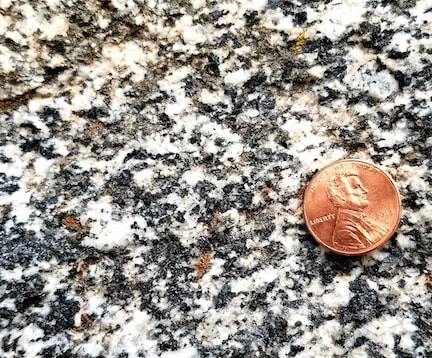Now I'd like to take you on a subterranean journey, miles deep into the Earth's crust. Oddly enough, to take this journey, we've come high up into the Sangre de Cristo Mountains above Santa Fe, to a rugged landscape covered in pine and fir, nearly 2 miles above the sea.
These attractively speckled rocks are durable enough to carve your countertop - or your tombstone - from. The silicate minerals that compose them are about the size of a grain of wheat, hence their name, granite, after the Latin "granum" for grain.
These attractively speckled rocks are durable enough to carve your countertop - or your tombstone - from. The silicate minerals that compose them are about the size of a grain of wheat, hence their name, granite, after the Latin "granum" for grain.
These rocks are entirely crystalline, without a trace of the glassy or stony material you'd find in a volcanic rock. The interlocking crystals are uniformly distributed. They have none of the earmarks of a sedimentary rock, no cemented-grain texture, no water-soluble components, no stratification, no fossils.
The relationship of these granitic rocks to their neighbors is curious. The granites intrude and cut across older rocks, which suggests they are sub-volcanic rocks like those we saw in the Cerrillos. But the larger bodies of granite seem to be miles thick and many miles wide, dimensions far greater than the blister-like intrusions in the Cerrillos. And the rocks into which the granites are intruded have textures that indicate they have been strongly heated and deformed over huge areas, rather simply showing local contact effects
Apparently we are looking at magma that was forced into place at great depths in the Earth crust, in an environment of crustal rock already near its own melting point.
Conditions must have been ideal for the growth of crystals. Molten bodies of these dimensions would have been very slow to cool. They would have been insulated from temperature changes by miles of overlying rock. Confining pressures would have been sufficient to keep all the "juices" sealed in, where they could facilitate the migration of atoms to their proper places in crystalline structures.
Suspended in a viscous silicate womb, crystals nucleated randomly, and spread until growth was halted by meeting neighboring crystals. Silicates hungry for iron or calcium took the lead in this slow solidification. Those wanting sodium and potassium soon followed. Once all the metallic elements were consumed, pure silica filled in the final spaces as quartz, binding the whole mass into a very durable rock.
A rock strong enough to hold up a mountain range.
The relationship of these granitic rocks to their neighbors is curious. The granites intrude and cut across older rocks, which suggests they are sub-volcanic rocks like those we saw in the Cerrillos. But the larger bodies of granite seem to be miles thick and many miles wide, dimensions far greater than the blister-like intrusions in the Cerrillos. And the rocks into which the granites are intruded have textures that indicate they have been strongly heated and deformed over huge areas, rather simply showing local contact effects
Apparently we are looking at magma that was forced into place at great depths in the Earth crust, in an environment of crustal rock already near its own melting point.
Conditions must have been ideal for the growth of crystals. Molten bodies of these dimensions would have been very slow to cool. They would have been insulated from temperature changes by miles of overlying rock. Confining pressures would have been sufficient to keep all the "juices" sealed in, where they could facilitate the migration of atoms to their proper places in crystalline structures.
Suspended in a viscous silicate womb, crystals nucleated randomly, and spread until growth was halted by meeting neighboring crystals. Silicates hungry for iron or calcium took the lead in this slow solidification. Those wanting sodium and potassium soon followed. Once all the metallic elements were consumed, pure silica filled in the final spaces as quartz, binding the whole mass into a very durable rock.
A rock strong enough to hold up a mountain range.


 RSS Feed
RSS Feed
